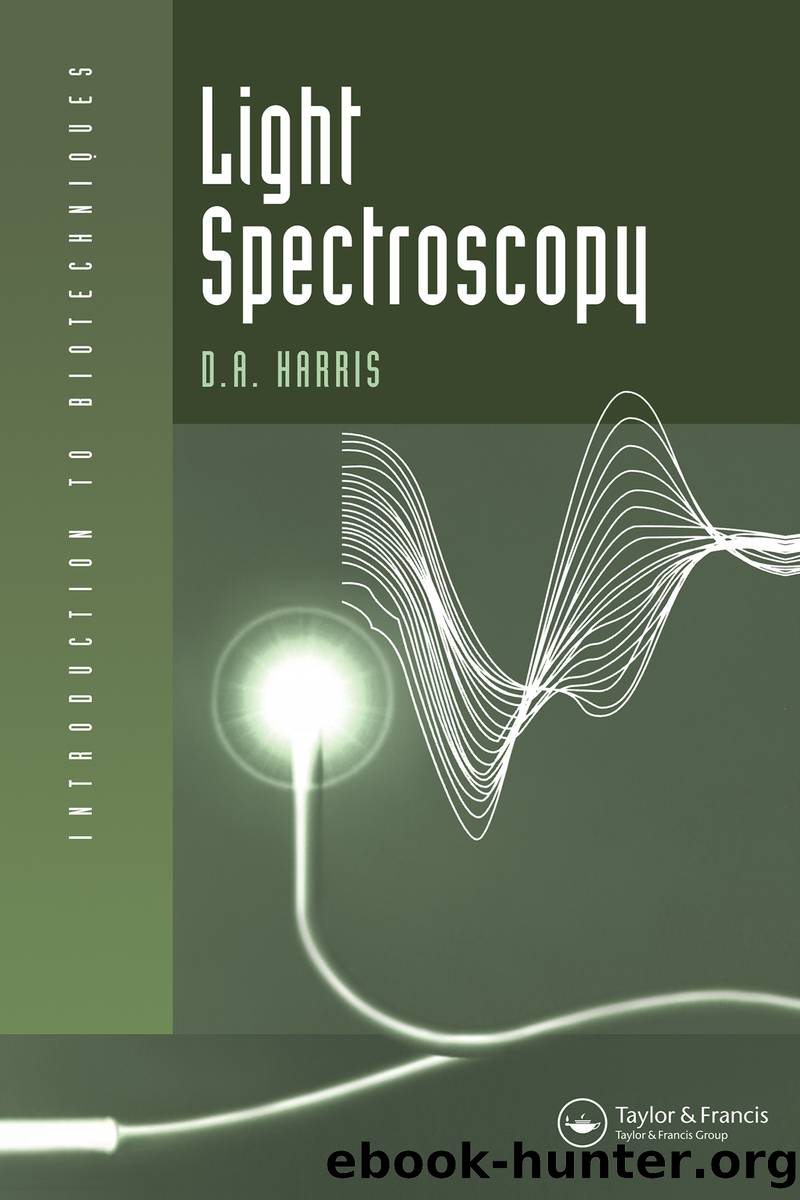Light Spectroscopy by Dr David Harris;

Author:Dr David Harris;
Language: eng
Format: epub
ISBN: 9781000140934
Publisher: CRC Press (Unlimited)
Published: 2020-01-15T00:00:00+00:00
6.8 How to improve resolution
The resolution of a spectrophotometer is its ability to distinguish between two closely spaced absorption bands. As noted above, this is maximized by (i) choosing a sufficiently narrow slitwidth (spectral bandwidth) so that the observed peak width is no broader than its natural bandwidth (Section 6.4.2) and (ii) choosing an appropriate scan speed and response time (Section 6.4.3). However, in systems whose spectra are complex because (i) multiple absorbing components are present and/or (ii) significant light scattering occurs, additional measures may be needed to resolve individual components.
6.8.1 Difference spectra
The most widely used technique for enhancing resolution is to measure a difference spectrum. In principle, the method is identical to that described above for subtracting a baseline; the spectrum of a reference is subtracted from that of the sample under study either in a single measurement (using a dual beam instrument) or sequentially, by storing the reference data in the instrument prior to measuring the sample (in a single beam instrument). The difference in method lies in the composition of the two solutions used: to measure a difference spectrum both sample and reference contain the chromophore under study, but in the sample, the chromophore has been chemically modified. Thus, for example, a difference spectrum of reduced minus oxidized cytochrome c is shown in Figure 6.7a, in comparison with the spectrum of each individually (see Chapter 1, Figure 1.8). The difference spectrum clearly shows that, on reduction, a peak appears at 550 nm, while absorbance falls at about 535 nm. Difference spectra (light minus dark) of chloroplasts reveal both cytochrome oxidation and the photochemical reaction centers, which are bleached (at 682 and 700 nm) on illumination (Figure 6.7b). Similar observations can be made, for example, during the reaction of a protein with a chromogenic reagent (Figure 6.8).
The increase in resolution resulting from this approach is clearly seen in Figure 6.9, where the spectrum of a highly turbid yeast suspension is shown. The âabsoluteâ spectra of the suspension, in both reduced or oxidized state, are dominated by light scattering from the solution and, as a result, appear featureless and very similar. However, in the reduced minus oxidized difference spectrum, a number of peaks are resolved, corresponding to various cytochromes within the cell (the peak at 550 nm representing cytochrome c, for example). The levels and redox potentials of these individual components in vivo can therefore be studied.
Referring back to Figures 6.6â6.8, features of difference spectra can be seen to include positive peaks (higher absorbance under sample conditions: appearance of a product), and negative peaks (higher absorbance under reference conditions: disappearance of a reactant). There are also points where absorbance is identical in both sample and reference conditions, namely, ÎA = 0 over the change studied and the difference spectrum crosses the baseline. These are isosbestic points (iso, equal; sbestos, extinguished) (see Section 1.4). Isosbestic points occur when there are only two species involved in the change, that is, a single reactant produces a single product. (Note that the presence
Download
This site does not store any files on its server. We only index and link to content provided by other sites. Please contact the content providers to delete copyright contents if any and email us, we'll remove relevant links or contents immediately.
| Electron Microscopes & Microscopy | Experiments & Projects |
| Measurement | Microscopes & Microsocopy |
| Scientific Instruments | Telescopes |
| Time | Methodology & Statistics |
Thing Explainer by Randall Munroe(3782)
Hands-On Genetic Algorithms with Python by Eyal Wirsansky (2020) by Unknown(3661)
The Elements by Theodore Gray(2846)
The Meaning of it All by Richard Feynman(2213)
Make by Mike Westerfield(2197)
Every Tool's a Hammer by Adam Savage(1795)
Science Experiments You Can Eat by Vicki Cobb(1738)
The Perfectionists by Sara Shepard(1700)
Martin Gardner's Science Magic by Martin Gardner(1599)
Raspberry Pi Electronics Projects for the Evil Genius (Tab) by Norris Donald & Norris Donald(1587)
Elephants on Acid: And Other Bizarre Experiments by Alex Boese(1487)
The Perfectionists by Simon Winchester(1487)
Handbook of Modern Sensors by Jacob Fraden(1474)
Elephants on Acid by Boese Alex(1458)
Synchrotron Light Sources and Free-Electron Lasers by Eberhard J. Jaeschke Shaukat Khan Jochen R. Schneider & Jerome B. Hastings(1452)
Tesla by Carlson W. Bernard(1415)
The Science of Food by Marty Jopson(1383)
The Meaning Of It All by Richard P. Feynman(1345)
125 Physics Projects for the Evil Genius by Silver Jerry(1339)
